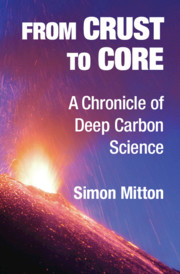Book contents
- From Crust to Core
- From Crust to Core
- Copyright page
- Dedication
- Contents
- Foreword
- Acknowledgments
- Introduction
- 1 Why Carbon in Earth Matters
- 2 The Origin of Deep Carbon in Deep Space
- 3 Deliveries of Cosmic Carbon Continue
- 4 On the Nature of Earth’s Interior
- 5 Earth’s Physical Interior Revealed
- 6 Thousands, Millions or Billions
- 7 Physics and Chemistry of Deep Earth
- 8 Confronting the Continental Drift Conundrum
- 9 The Mid-Atlantic Ridge and Rift Valley
- 10 Earth’s Deep Dynamics Discovered
- 11 Reversals of Fortune
- 12 Deep Carbon
- 13 Carbon-Bearing Phases in the Mantle
- 14 Diamond in the Mantle
- 15 Deep Life
- Glossary
- Biographical Notes
- Index
- References
14 - Diamond in the Mantle
Published online by Cambridge University Press: 19 December 2020
- From Crust to Core
- From Crust to Core
- Copyright page
- Dedication
- Contents
- Foreword
- Acknowledgments
- Introduction
- 1 Why Carbon in Earth Matters
- 2 The Origin of Deep Carbon in Deep Space
- 3 Deliveries of Cosmic Carbon Continue
- 4 On the Nature of Earth’s Interior
- 5 Earth’s Physical Interior Revealed
- 6 Thousands, Millions or Billions
- 7 Physics and Chemistry of Deep Earth
- 8 Confronting the Continental Drift Conundrum
- 9 The Mid-Atlantic Ridge and Rift Valley
- 10 Earth’s Deep Dynamics Discovered
- 11 Reversals of Fortune
- 12 Deep Carbon
- 13 Carbon-Bearing Phases in the Mantle
- 14 Diamond in the Mantle
- 15 Deep Life
- Glossary
- Biographical Notes
- Index
- References
Summary
Diamonds form deep in the mantle, where they mostly remain unless propelled to the surface in a volcanic eruption. Diamond is by far our most important mineral messenger for discovering the history and chemistry of Earth’s convecting mantle. Diamond provides a window to otherwise inaccessible geological processes that churned away 100 kilometres underground and often occurred billions of years ago.1 Chemically, diamond is exceptionally pure: 99.9 percent or more elemental carbon. Diamond lasts almost forever, being the hardest known natural material by quite a margin. And since 1948, De Beers has used the marketing tagline “A diamond is forever” continuously to promote its diamond engagement rings.
- Type
- Chapter
- Information
- From Crust to CoreA Chronicle of Deep Carbon Science, pp. 282 - 302Publisher: Cambridge University PressPrint publication year: 2020



